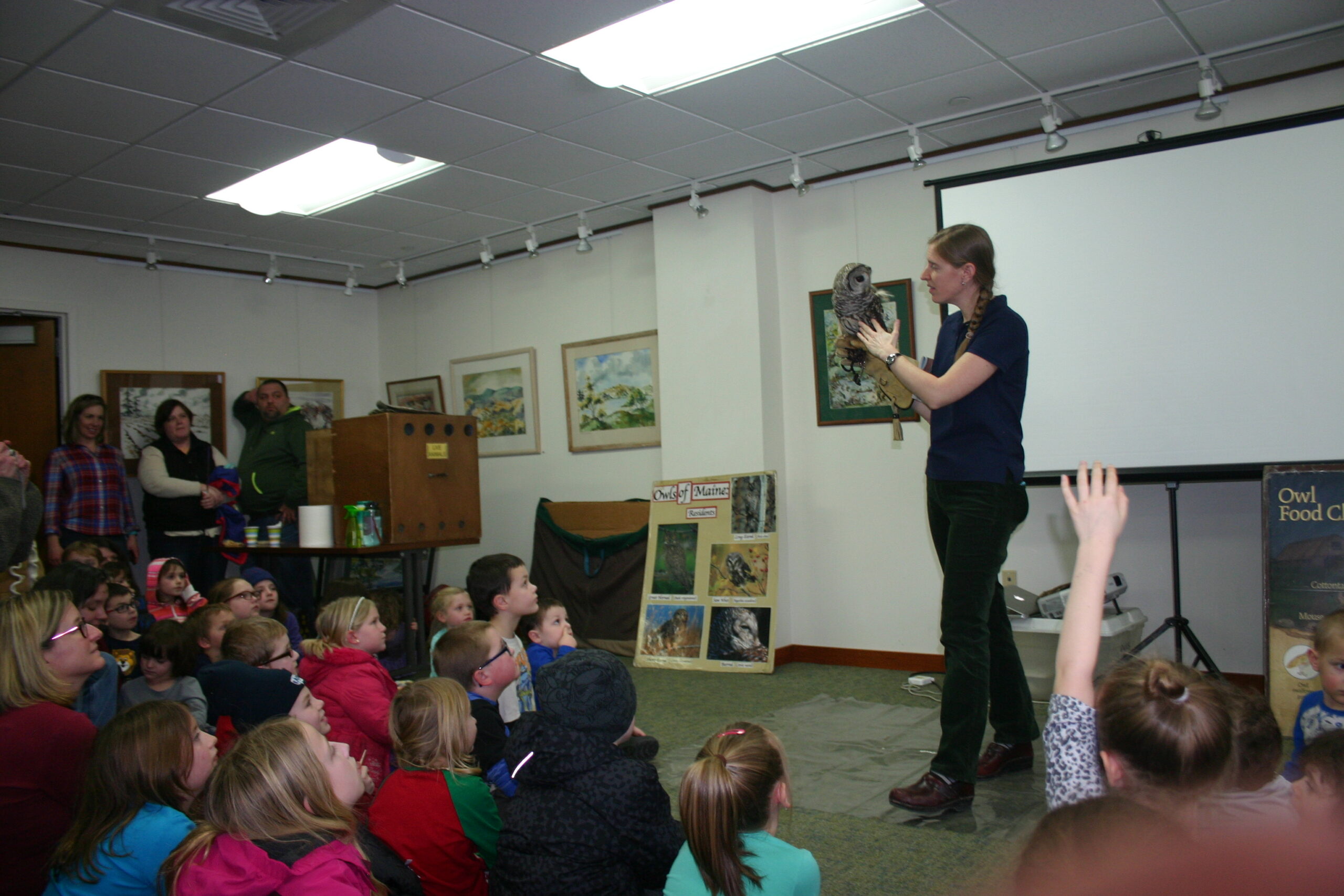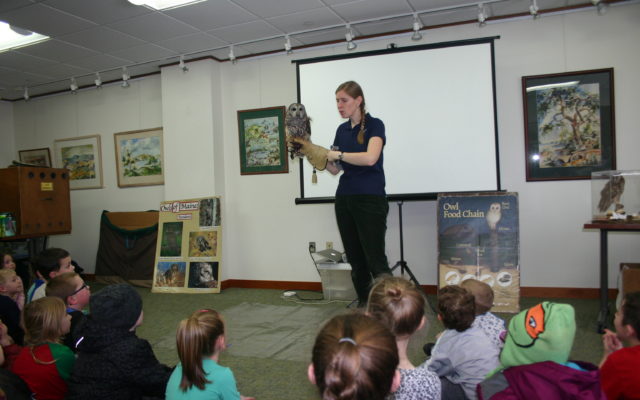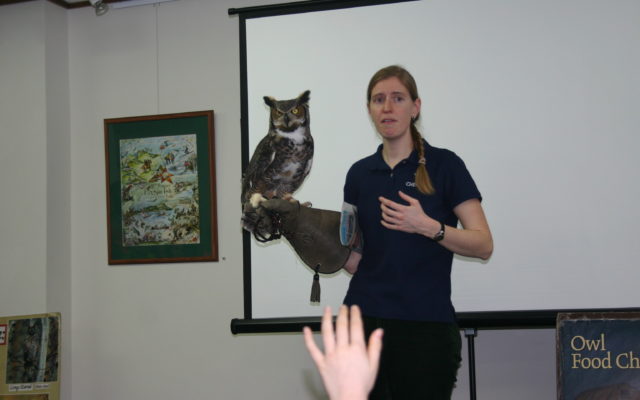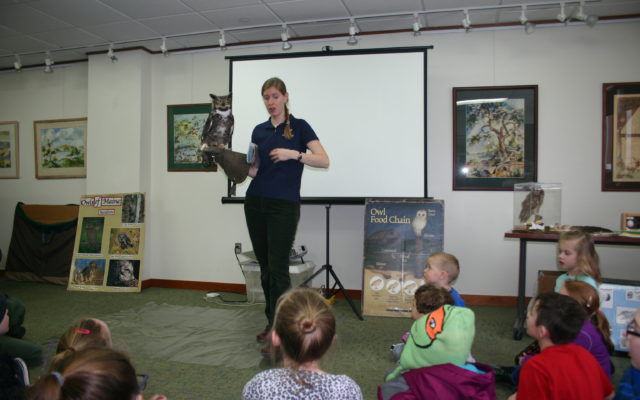
PRESQUE ISLE, Maine — More than 30 children crowded into the front row and many other spectators filled the Akeley Gallery at the public library Saturday to learn more about Maine owls and get a glimpse of two live owls from the Chewonki Traveling Natural History Program.
About half of the children sitting on the floor in the front of the room at the Mark and Emily Turner Memorial Library raised their hands when asked if they had ever seen an owl live before.
“That’s great,” presenter Emma Balazs told the children before displaying a picture of a great horned owl on the projector screen behind her. “But do you know how owls can hear so well?”
After a few seconds Balazs said, “They’re face is shaped like a mask, which is called a ‘facial disk,’ and that collects sound and brings it into their ears so that they can hear and catch prey.”
The youngsters seemed fascinated as Balazs continued with her presentation, “Owls of Maine.”
Chewonki is a an environmental education organization based in Wiscasset, that has many programs such as Maine Coast Semester, Adventures for Girls, Camp for Boys and Outdoor Classrooms. As part of the Traveling Natural History Program, Chewonki takes in animals that have sustained injuries too disabling to return to the wilderness and takes them to schools, libraries and community centers throughout Maine to educate children about the importance of protecting the environment and its inhabitants.
Balazs told those gathered Saturday afternoon about the many adaptations that owls have to help them survive in the Maine wilderness such as sharp talons on their feet to grab prey, wings that don’t make any noise as they fly and large eyeballs that allow the nocturnal animals to see well at night. She passed out many real owl talons, feathers and wings that were donated to Chewonki after those animals were no longer living.
As Balazs showed pictures of owls such as the saw-whet owl, great gray Owl, barred owl, barn owl, eastern screech owl, long-eared Owl, short-eared owl and screech owl she explained the differences between each and played audio of their unique calls. One of her examples was how barred owls and barn owls look different despite their similar names. While barred owls have brown and white stripes, or “bars,” dark eyes and a yellow beak, Barn Owls have white, heart-shaped faces.
The children became most excited, however, when Balazs announced that she would bring out from their enclosed cages two of Chewonki’s resident owls, which she had brought along with her — barred owl, Beria, and great horned owl, Archie. Throughout the presentation, Beria and Archie stayed in their large enclosed cages because owls get nervous when they meet new people and they don’t like loud noises, Balazs explained. She took each owl out of their cage one at a time.
While staying as quiet as they could, the children gasped when they saw Beria for the first time and peered at her while Balazs explained how the barred owl came to Chewonki.
“She flew into a car and broke her left wing, which means that she can’t stick the wing out all the way,” Balazs said. “When owls can’t stick their wings out they can’t fly, so they’re not able to hunt for food.”
Balazs brought Beria around the room for everyone to see before putting her back in her cage and bringing out Archie, a great horned owl, who was found as a young owl after falling from his nest. After Chewonki discovered that he was blind in one eye, Archie became a permanent resident of the Traveling Natural History Program.
“The rehabers at Chewonki do everything they can to help animals recover and go back into the wild, but sometimes they aren’t able to,” Balazs said. “Some owls become ‘teachers’ for our traveling program so that they can show all of you why owls are so important to protect.”
The Chewonki presentation proved to be a hit with both children and their parents.
“I like how we got to learn about the owls before we saw them and how she let us ask questions if we wanted to,” 12-year-old Zoe Locke, of Caribou, said.
Zoe’s father John Locke agreed. “I think it’s awesome that the library brought this program up here. We don’t have a lot of resources to learn about wildlife in this way, so I’m glad that they gave people the opportunity.”
Easton resident Justin Quint, 9, and his mother Christina Quint also had great things to say about Chewonki and “Owls of Maine.”
“I like holding the owl feathers and skulls and seeing the owls up close was really cool,” Justin Quint said.
Christina Quint said, “I enjoyed hearing all the different owl sounds because now when we’re in the woods we can know how to tell the difference between them.”
In addition to the Presque Isle presentation, another Chewonki staff member was at the Nylander Museum in Caribou to teach audience members there about mallard ducks and reptiles. Jan. 20 marked Chewonki’s return to Presque Isle, as staff gave a similar presentation on owls at the Mark and Emily Turner Memorial Library last year.
“Seeing the wonder on peoples’ faces, both young and old, when they see the owls up close never gets old for me,” Balazs said, after her presentation. “I hope that the spark I see on their faces grows into a greater love for animals and helps them respect the nature that’s around them.”
- Beria, a barred owl, was one of two resident Chewonki owls that visited the Mark and Emily Turner Memorial Library in Presque Isle on Saturday, Jan. 20. Chewonki is an environmental education program based in Wiscasset that hosts many programs geared toward educating youth about wildlife in Maine. (Melissa Lizotte)
- Chewonki Traveling Natural History Program Coordinator Emma Balazs shows Beria, a barred owl, to children at the Mark and Emily Turner Memorial Library in Presque Isle on Saturday, Jan. 20. Beria came to Chewonki after breaking her left wing, which prevented her from returning to the Maine wilderness. (Melissa Lizotte)
- Emma Balazs, coordinator of Maine-based Chewonki’s Traveling Natural History Program, shows audience members Archie, a great horned owl who came to Chewonki as a young owl. Archie is unable to live in the wild due to being blind in one eye. (Melissa Lizotte)
- Emma Balazs, coordinator of Maine-based Chewonki’s Traveling Natural History Program, shows audience members Archie, a great horned owl. (Melissa Lizotte)











